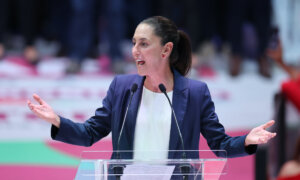Commentary
A recent book takes up why the controversial California High-Speed Rail (HSR) project remains stalled at the station. It’s “How Big Things Get Done: The Surprising Factors That Determine the Fate of Every Project, from Home Renovations to Space Exploration and Everything In Between,” by Bent Flyvbjerg, executive chairman of Oxford Global Projects, and Dan Gardner, journalist.
The book is relevant because this boondoggle still is chugging along. Earlier this month, the Biden administration announced it would spend “$8.2 billion in new funding for 10 major passenger rail projects across the country, including the first world-class high-speed rail projects in our country’s history.”
That included “creating a high-speed rail line through California’s Central Valley to ultimately link Los Angeles and San Francisco, supporting travel with speeds up to 220 mph,” meaning $3 billion for the HSR. They’re still promoting the fantasy of a statewide project.
Other projects included $3 billion for “building a new high-speed rail system between California and Nevada, which will serve more than 11 million passengers annually.” So Californians already broke from the high cost of living can blow their mortgages gambling in Las Vegas. And the grants would deliver “significant upgrades to frequently-traveled rail corridors in Virginia, North Carolina, and the District of Columbia; and upgrading and expanding capacity at Chicago Union Station in Illinois, one of the nation’s busiest rail hubs.”
The projects would “open up safe, comfortable, and climate-friendly travel options to get people to their destinations in a fraction of the time it takes to drive.” Note the emphasis on the climate. That’s how they hope to convince the taxpayers in other parts of the country these projects are worth the investment, even though the HSR universally is recognized as an unachievable project, except possibly for a short line in the Central Valley.
Big Projects That Work
Mr. Flyvbjerg and Mr. Gardener’s “Big Things” mainly is about building successful projects, which have such qualities as:
- Running the project as “a single, determined organism. Everyone must row in the same direction: toward delivery”
- Hiring a masterbuilder
- “Think slow, act fast,” which was pretty much the opposite of HSR, which was conceived hastily, passed in a rush by California voters in 2008, then slowly enacted over the past 13 years as costs rose
- “Know that your biggest risk is you,” your own “behavioral biases”
Successes cited include the Empire State Building. It was “completed at astonishing speed, in large part due to architect William Lamb’s focus on developing a carefully tested plan that would empower a smooth, swift delivery.” And the Hoover Dam, which when completed in 1936 “came in under budget and ahead of schedule. In the annals of big projects, it is a legend.” The key was an experienced team around Frank Crowe, the engineer who managed the project and had built many dams over the years.

An aerial image of construction of a high-speed rail project through the Central Valley in Fresno, Calif., on Aug. 26, 2021. (Patrick T. Fallon/AFP via Getty Images)
California’s Fantasyland Rail
But the book also includes disasters and starts with California’s ridiculous HSR plan.
It begins by describing the propaganda push behind Proposition 1 in 2008, by which voters approved the project. Voters “were asked to imagine themselves at Union Station in downtown Los Angeles, on board a sleek silver train. Departing the station, the train slips quietly through the urban sprawl and endless traffic jams and accelerates as it enters the open spaces of the Central Valley, until the countryside is racing by in a blur. Breakfast is served. By the time attendants clear coffee cups and plates, the train slows and glides into another station. This is downtown San Francisco. The whole trip took two and a half hours, not much more than the time it would take the average Los Angeleno to drive to the airport, clear security, and get on a plane to queue on the tarmac, waiting for departure. The cost of the train ticket was $86. ... And for a total cost of $33 billion it would be ready to roll by 2020. In a statewide referendum, Californians approved.”
There’s a little more to it than what the book describes. Prop. 1 was pushed hard by Gov. Arnold Schwarzenegger, a highly charismatic promoter from his years of hawking his action movies. Despite that, and being backed by the powerful construction companies and public-employee unions, the initiative garnered only 52.6 percent of the vote.
After losing four reform propositions in 2005, the HSR was part of Mr. Schwarzenegger’s attempt to reclaim his reputation, as I detailed in The Epoch Times in “The Media Is Helping Schwarzenegger Rewrite His Governorship.” Realism didn’t matter to him any more than in the plot to “Total Recall.”
Nowadays, it’s laughable to read the Argument in Favor of Proposition 1 put before voters in the official pamphlet: “California’s transportation system is out-of-date and deteriorating. We need options to poorly maintained roads, jammed runways and congested highways.” But the money blown so far sure could have filled a lot of potholes. It would have made more sense to get Disneyland to extend its Monorail to San Francisco.
“Big Things” describes the situation today, 15 years after the voters were gulled. Construction started, “but the project was hit with constant delays. Plans were changed repeatedly. Cost estimates soared, to $43 billion, $68 billion, $77 billion, then almost $83 billion,” and now to more than $100 billion. “But the truth is that nobody knows what the full, final cost will be.”
The book notes that in 2019, Gov. Gavin Newsom announced only a truncated HSR system would be built, the 171-mile section between Merced and Bakersfield in the Central Valley. That’s the section Mr. Biden just announced would receive aid from federal taxpayers.
“But when that inland section is completed, the project will stop,” the book says, unlike what the Biden announcement said. “It will be up to some future governor to decide whether to launch the project again and, if so, figure out how to get the roughly $80 billion—or whatever the number will be by then—to extend the tracks and finally connect Los Angeles and San Francisco.”
“Big Things” notes the HSR’s cost just for the Merced-Bakersfield line is higher than the annual gross domestic product of Honduras or Iceland. Yet it links “two towns most people outside California have never heard of. It will be—as critics put it—the ‘bullet train to nowhere.’
“How do visions become plans that deliver successful projects? Not like this. An ambitious vision is a wonderful thing. California was bold. It dreamed big. But even with buckets of money, a vision is not enough.”

A full-scale mock-up of a high-speed train is displayed at the Capitol in Sacramento, Calif., on Feb. 26, 2015. (Rich Pedroncelli/AP Photo)
Can HSR Be Fixed?
“Big Things” includes another boondoggle project that broke down: Hong Kong’s XRL, the world’s first fully underground high-speed rail system, linking the city with the mainland city of Guangzhou. Construction was supposed to last from 2011 to 2015, but only half the work was completed, with more than half the budget spent.
The project hired Mr. Flyvbjerg and his firm to fix it. The main problem was making unrealistic forecasts based on Hong Kong’s regular rail projects, which “created a delivery schedule that was doomed from the outset. When work inevitably fell behind schedule, managers and workers were blamed. A downward spiral of failure and recrimination followed.”
Because it was the first totally underground high-speed rail project, there were no precedents. But they looked at almost 200 nearly similar projects from around the world and made new, realistic estimates, then got to work. They completed the project in 2018, “on budget and three months ahead of schedule.”
Can that be applied to the HSR? No. The mistakes made 15 years ago were too grave. But if the attempt were made, the first step would be to follow the Flyvbjerg method and look for close comparison projects. There are other high-speed rail projects around the world, but none attempts what the HSR would: connecting two cities, Los Angeles and San Francisco, 400 miles apart, separated by a lightly populated area.
By contrast, Hong Kong to Guangzhou is just 80 miles, one-fifth the distance. And consider these population densities, per square mile, and the overall population:
• Los Angeles: 8,304 and 3.9 million
• San Francisco: 17,237 and 808,437
• Hong Kong 17,614 and 7.5 million
• Guangzhou: 6,500 and 18.7 million
And in between those two cities are:
• Shenzhen: 23,000 and 17.6 million
• Dongguan: 11,000 and 10.5 million
Add it up: Los Angeles plus San Francisco, total population: 4.7 million. Hong Kong and Guangzhou combined: 26.4 million, nearly 6 times as many. Adding in Shenzhen and Dongguan: 54.3 million, almost 12 times.
Finally, I don’t want to leave the impression I’m praising communist China, which unfortunately has controlled Hong Kong since 1997. They certainly have their own boondoggles, including large parts of dictator Xi Jinping’s Belt and Road Initiative (BRI). As Asia Unbound wrote in April, “The real reason why the BRI has struggled to sustain itself is not due to debt traps or predatory lending, but something far more mundane: poor risk management and a lack of attention to detail and cohesion from the Chinese state-owned enterprises and banks, private companies, and local governments involved.”
But for Hong Kong’s XRL project, they followed Mr. Flyvbjerg’s program, hired him as a consultant, realized they still had realistic chances of succeeding, and moved ahead.
By contrast, California’s HSR has been an unrealistic boondoggle from the beginning and is unfixable. The money spent would have been better used fixing the roads and, to make flying more comfortable, sprucing up the state’s dilapidated airports—which when operated efficiently can still take you from Los Angeles to San Francisco in about an hour.
















